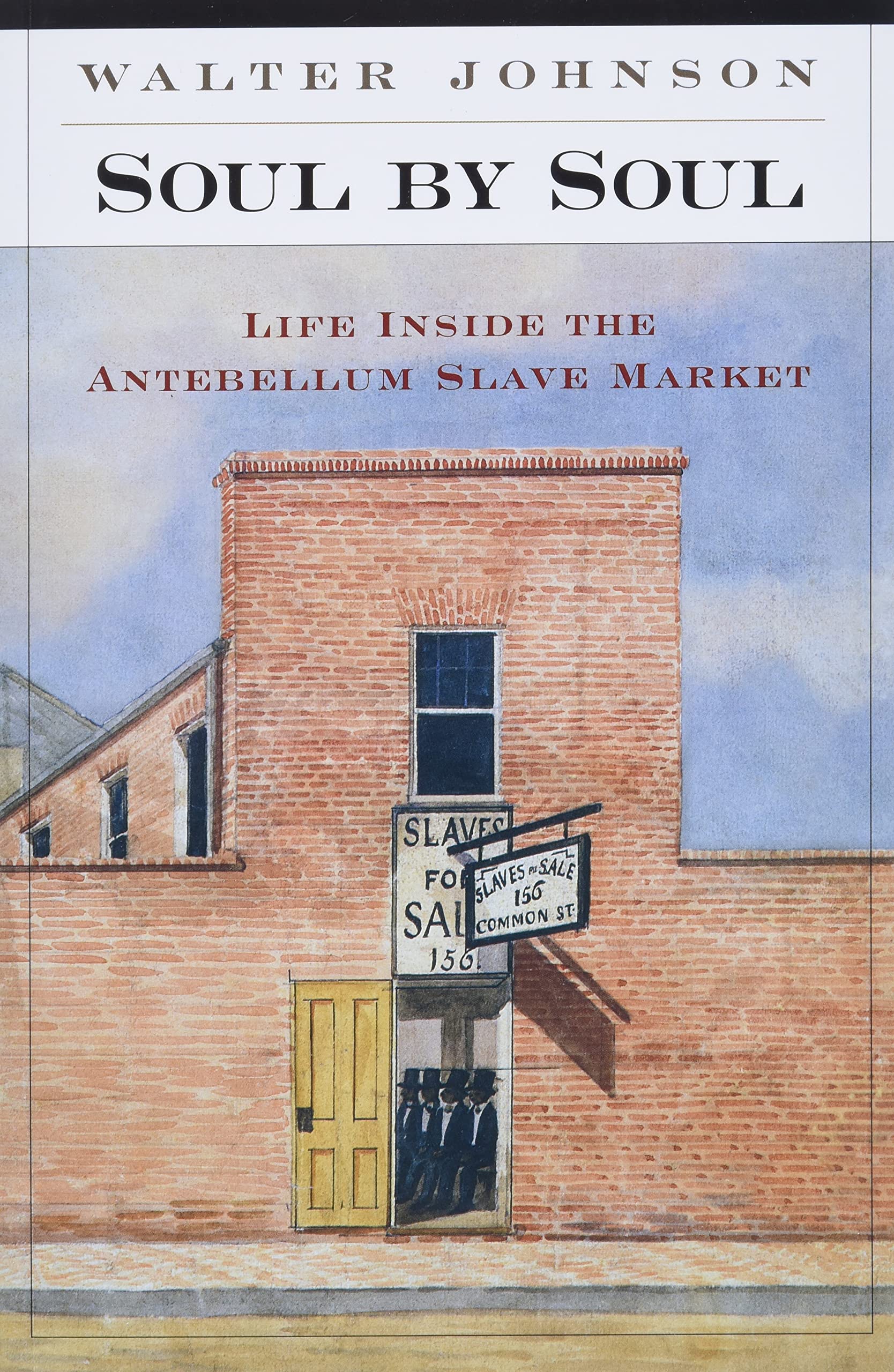Customer Services






Soul by Soul: Life Inside the Antebellum Slave Market
R**D
Brilliant and Very Readable!
Walter Johnson’s Soul By Soul: Life Inside the Antebellum Slave Market broadly focuses on the history of slavery, but Johnson uses that to explore how the geographic and cultural space of the slave market, specifically those in New Orleans, shaped ideas of wealth, race, gender, and social status for all members of Southern society regardless of gender, race, or condition of bondage.Johnson seeks to answer how the transformative process of slavery, in which people became objects, affects all members of Southern society and transformed that society itself.Johnson argues that the slave pens in New Orleans offer insight into all aspects of Southern slavery. Johnson writes, “In the slave pens, the yet-unmade history of antebellum slavery could be daily viewed in the freeze framed detail of a single transaction on its leading edge – a trader, a buyer, and a slave making a bargain that would change the lives of each.” Johnson explores these transactions from the point of view of each. According to Johnson, “The abstract value that underwrote the southern economy could only be made material in human shape – frail, sentient, and resistant.” Fully aware of these contradictions, slaveholders based their social relationships on slavery and tied their honor to the choices the made in the marketplace. Johnson writes, “By buying a slave, [J.B.] Alexander had bought himself a public stake in the world of white men: he was a man who was worthy of notice.” Even the measurement of time was tied to the slave market, with sales and purchases depending on the agricultural needs of plantation owners. A man could assert his patriarchal benevolence toward his family by purchasing a slave to aid their family. Writes Johnson, “By publicly framing their purchases in terms of the needs of their white dependents, these men reframed the leisure of their wives as evidence of their own virtue – their wives would not have to wash or wait or nurse, they would see to that.” In this way, Southern honor was tied to a man’s fortunes and skill as a slaveholder. Johnson writes, “‘Affairs of honor’ were more likely to be played out in the slave market than on the dueling ground.” Finally, Johnson demonstrates that slaves could take advantage of the buyers’ and traders’ expectations to maintain families, exercise a modicum of choice in their owners, and even escape. The system of buying on trial “gave slaves an opportunity to examine their buyers and choose whether to match or subvert their evident expectations.” The slave market represented the nexus of all these interchanges.Johnson primarily builds upon the work of Frederic Bancroft and Michael Tadman. He also draws upon Eugene Genovese and James McPherson.Johnson uses four types of sources. He relies on the narratives of escaped slaves first and foremost. Additionally, Johnson uses the docket records of disputed slave sales, slaveholders’ own letters, and various records of sales from notarized acts to record books and advertisements. Johnson contextualizes slave narratives with “sources produced by slaveholders and visitors to the South.” Further, Johnson assumes the docket records “contain only lies,” though he suggests these lies must have fit an understood pattern for them to seem plausible in court.
B**A
Powerful book that uses the slave market to provide insight into the brutal world of US slavery
Powerful book on a brutal topic - Johnson narrows the focus to the slave market and in the process is able to provide a number of insights about the broader topic of US slavery. Johnson examines a number of topics including one that may be relatively familiar - for instance, how being sent to the slave market represented a traumatic change for an enslaved person - being separated from the place, people and slave master they knew - but Johnson also pulls out other elements that may not be as well known. For instance, the pressure placed on enslaved people to fulfill a role that the seller intended to increase their marketability, but also the agency that they had to help encourage a sale to potentially less brutal slaveowner or discourage a sale to a potentially more brutal slaveowner. Johnson also explores the different roles in the slave market - the seller, the slave trader, and the enslaved person.Johnson has written a powerful book that uses the narrower topic of the slave market to provide insight into the brutal world of US slavery in the pre-Civil War era.
L**9
this book provides some great information and means of thinking exactly what informed the ...
Before I get into a review of the book, I want to lodge a complaint about the kindle version. There are no page options in this version, and that's really disappointing and aggravating. The kindle technology has been around long enough, there's no reason why this feature is not included. And considering the price of the kindle version, this feature should DEFINITELY be included. Or, at the VERY LEAST, clearly stated in the information page so that someone ordering it would know they weren't able to go by page numbers (especially important when discussing in a class or book club setting).The book itself is an interesting piece of scholarship on slavery through the lens of slave markets. A fascinating look at the process and system created, it's sure to raise as many questions as it answers and pushes the reader to think deeper about the complexity of the slave system. If you're looking to expand your understanding of slavery in the antebellum south, this book provides some great information and means of thinking exactly what informed the functioning of the system.
M**W
My professor made me buy it.
Besides being forced to read it, it was overall a great book.
I**E
Some Good Information but a Slow read
This title throws some light on the secondary market for slaves in the ante-bellum south. Most of us (myself included) may have assumed that the slave market was much as depicted in Roots, where Kunta Kinte was auctioned off. This was of course the primary market. The secondary market depicted in this book operated more like a used car lot, where prices were determined by negotiating with the slave trader. This was not an easy transaction to maneuver, since, unlike cars, there was no bluebook on slaves. This led to all sorts of criteria, both silly and common sense, to determine valuations. The assumptions of the slave-owning class played into the process, and slaves created mechanisms to influence the sale as well. This last may have been the most interesting observation of the book, at least for me.That said, the book drags. It has a lot of detail, maybe too much. It also seems that the author describes in painful detail a lot of common sense activity on the part of the buyers, sellers and slave themselves. It seems like sophisticated intellectual theories are constructed around normal human behaviors.All in all an informative volume. Not a page turner, but a good, book on a little researched topic..
E**H
Good read
I had to order this book for a collage course and I was pleasantly surprised by how much I enjoyed this book!
C**Y
Five Stars
Great book..
S**N
Five Stars
1005
Trustpilot
1 week ago
3 weeks ago